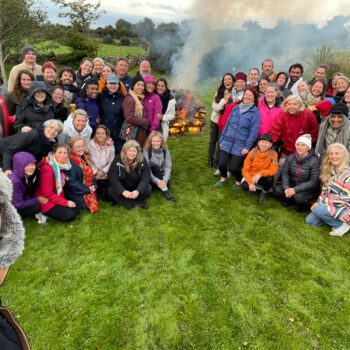Grief has been one of the most difficult yet transformative experiences of my life. In the past, my instinct was always to avoid it—to distract myself with work, relationships, or external comforts that kept me from truly sitting with my emotions. But the more I tried to outrun sadness, the more it lingered beneath the surface, showing up in unexpected ways: anxiety, emotional numbness, even physical tension in my body. It wasn’t until I made the conscious decision to meet my grief head-on, without resistance, that I truly began to process sadness.
The journey wasn’t easy. There were times when I wanted to retreat into old habits, to push away the pain and pretend I was fine. But I learned that grief, like any other emotion, isn’t something to be “fixed” or avoided—it’s something to be experienced and integrated. Through presence, conscious breathing, and self-inquiry, I discovered that grief wasn’t just about loss in the present moment, it was also revealing old, unresolved wounds from my past, offering me a chance to finally process emotions I had buried long ago.
Becoming Present with Grief
The first shift I made was deciding to actually sit with my grief instead of distracting myself from it. I had spent so much of my life avoiding emotional discomfort, thinking that if I just kept moving forward, the pain would eventually fade on its own. But what I realized was that grief doesn’t just disappear when we ignore it. It lingers, it festers, and it often resurfaces in unexpected ways.
I started by simply noticing how grief felt in my body. Instead of just saying, ‘I feel sad,’ I would ask myself, ‘Where do I feel this sadness?’ Sometimes it was a tightness in my chest, sometimes a dull ache in my stomach. There were even moments when my throat would feel constricted, as if holding back tears that I wasn’t allowing myself to release. Rather than resisting these sensations, I practiced just observing them, letting them be there without trying to change or suppress them.
Breathwork became a crucial part of this process. Whenever the emotions felt overwhelming, I focused on my breathing—slow, deep inhales and exhales, allowing each breath to create space for whatever I was feeling. I noticed that when I breathed consciously, the intensity of my grief didn’t necessarily go away, but it became more manageable. It felt like I was making room for the emotions rather than letting them consume me.
And as I created this space, I started noticing something unexpected—sometimes what I thought was grief wasn’t sadness at all. It was a mix of emotions, tangled together in a way I hadn’t fully understood before. Anger, fear, even guilt—all buried so deeply that they had collapsed into something that simply felt like sorrow. But as I sat with these emotions, I started to unravel them. Was this sadness truly mine? Or was I carrying the grief of past generations, the unexpressed emotions of those who had come before me?
Recognizing Ancestral Grief and Emotional Layers
One of the most profound realizations I had was that some of my grief wasn’t just from my own experiences. It ran deeper, having been woven into my being from before I was even born. The sorrow of my ancestors—those who had endured losses, hardships, and struggles without the space to fully grieve—had been passed down, held in my body, waiting to be acknowledged.
I came to understand that when I allowed myself to fully metabolize my sadness, I was also metabolizing the experiences of my ancestors. This metabolism, this alchemy, aided in healing not only my personal grief but also the trauma of the collective. I began to see grief as something greater than myself. It wasn’t just about my own heartbreaks or personal wounds; it was also a collective experience. I had inherited emotions that had never been expressed, pain that had never been given a voice. This understanding helped me be more compassionate with myself. Sometimes, when emotions felt overwhelming or confusing, I reminded myself that I wasn’t just processing my own grief—I was helping to release something much older.
I also noticed that grief often carried a mixture of different emotions. At times, I felt sadness, but underneath it was anger—anger at what had been lost, at the injustices that had shaped my family’s history, at the pain that had been silenced for generations. Other times, there was fear—the fear of fully feeling, of opening up to the depth of sorrow that I had spent years avoiding.
Instead of labeling these emotions as ‘bad’ or trying to separate them into neat categories, I allowed them to coexist. I let myself feel the full complexity of my grief, knowing that within the heaviness, there was also profound beauty.
The Beauty of Grief: Love, Depth, and Meaning
One of the most surprising things I learned was that grief itself is a reflection of love. The weight in my chest, the tears that fell without warning, the ache of missing something or someone—it was all evidence of how deeply I had loved, and how much meaning had been present in my life.
I started to see grief not as something to fear, but as something sacred. If I had never loved, I would not grieve. If I had never cared deeply, there would be no loss to mourn. In this way, grief became a reminder of the richness of my experiences—the proof that I had lived fully, that my heart had been open.
There is beauty in sadness. Not because suffering is necessary or fun, but because it means that something mattered. It means that we have connected, that we have felt, that we have been touched by something profound. So this realization softened the sharp edges of grief, making it something I could hold with tenderness rather than resistance.
Emerging from Grief with Greater Wholeness
Grief has changed me;it has softened me in some ways and strengthened me in others. It has taught me that healing isn’t about “getting over” something—it’s about integrating the experience in a way that allows us to move forward with more presence, wisdom, self-awareness and appreciation.
I won’t say that grief ever truly disappears, there are still moments when it resurfaces, sometimes unexpectedly. But I no longer fear it. I know now that grief is not a sign of weakness—it’s a sign of love, of depth, of being fully human.
And so, when sadness comes, I welcome it. I sit with it. I breathe through it. I allow it to shape me, not break me. Because every wave of grief, no matter how painful, carries the possibility of deeper healing. And that is a gift worth embracing.



